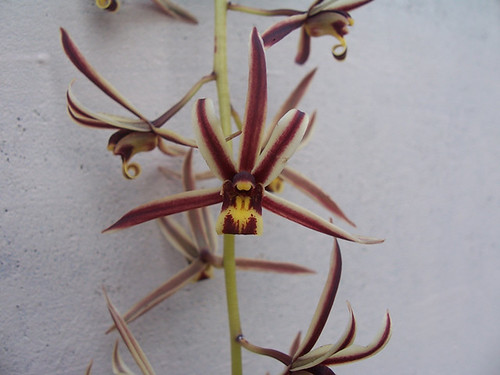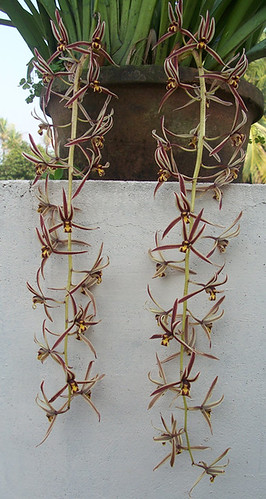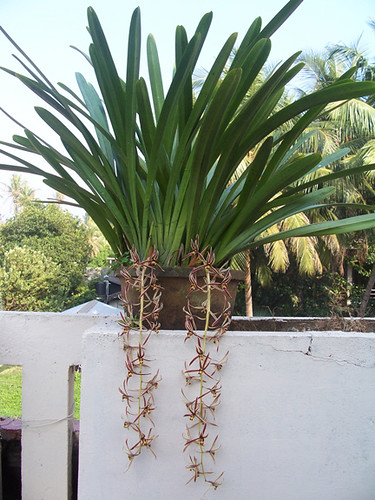Finally the heat of summer has begun and Cymbidium aloifolium is bursting into bloom. This plant was first recorded as Kansjiram Maravara by Hendrik Adriaan van Rheede tot Drakenstein, the then Dutch Governer of Cochin in his Hortus Malabaricus which is a treatise on the medicinal plants found in the Malabar region of India which was the hub of the spice trade in those days. The plant was thus named because it was found growing on a Kansjiram tree (Strychnos nuxvomica). Maravara which is a corruption of Maravazha refers to orchids in general. This plant has leathery belt shaped leaves measuring between 25 and 60 cm long and about 3 cm wide. It blooms during the month of April with pendulous racemes carrying around 10 to 30 flowers which last for about a week. The flowers have a very faint musty smell to them.
Please note that this is the same plant referred to as Cymbidium bicolor in Du Puy & Cribb's 'The Genus Cymbidium'.




Dear Prejith,
ReplyDeleteHow do you distinguish between C. bicolor and C.aloifolium. I am totally confused.
Regards
Mathew
The easiest way to arrive at a decision is to look for striping on the lips. C. aloifolium has stripes while C. bicolor does not.
ReplyDeleteWhile most of the world has accepted the above plant to be C. bicolor, Indian taxonomists still regard this to be the other way round; the reason I've labeled this C. aloifolium.
Regards,
Prejith.
I thought it had something to do with the leaves. Thanks any way!!
ReplyDeleteRegards
Mathew
We saw both long leaved and short leaved varieties in Wynad but they were all the same species. Leaf length I think is more related to the intensity of sunlight. The shorter leaved ones were standing in full sun.
ReplyDeleteHey, I always thought it was Cymbidium Bicolor :(
ReplyDeleteI have a Cymbidium Dyanum, which is almost 25 years old and stopped blooming a decade ago. I am still hoping someday it will bloom.
Nirupama,
ReplyDeleteCym. bicolor is the accepted nomenclature for this plant since that is what is mentioned in the book 'The Genus Cymbidium' by DuPuy and Cribb. Indian taxonomists however differ in their opinion since they say this plant was first recorded in Malabar, India by Van Rheede in his Hortus Malabaricus and it was based on the drawings in this book that Carl Linnaeus classified his Epidendrum aloifolium which later on came to be known as Cymbidium aloifolium. So I have left it as such for now.
Can you send a picture of the Cym. dayanum to my mail vandasrcool@rediffmail.com ?
Sure I will send the picture. When it bloomed I did not have a digi cam, so will be scanning the picture and sending it you.
ReplyDeleteI also saw another orchid in bloom in Nandi hills and I could not identify it. I will sending the picture of that too.
Thanks a ton!
Nirupama
yes this is aloifolium. :)
ReplyDeletewhere can i get cymbidium plants in bangalore?. i am looking for warm verieties. thanknyou
ReplyDelete